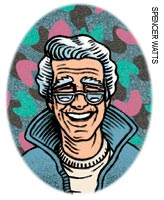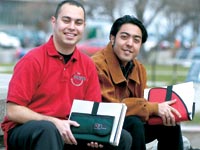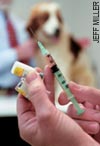Research
Happy Days Survey in Reruns
 Richie Cunningham had a midlife
crisis. Ralph Malph ended up as an investment banker.
The Fonz is worried about retirement, but he's looking
forward to spending less time at the office and more
time teaching his grandkids how to ride a Harley.
Richie Cunningham had a midlife
crisis. Ralph Malph ended up as an investment banker.
The Fonz is worried about retirement, but he's looking
forward to spending less time at the office and more
time teaching his grandkids how to ride a Harley.
It's hard to imagine such possibilities for the
boys of Happy Days, frozen as they are in the perpetuity
of television fantasy. But for Wisconsin's real Class of
1957, life has rolled on. And thanks to a monumental
research project begun at UW-Madison more than forty
years ago, researchers have a pretty good idea of what
those lives have been like.
The Wisconsin Longitudinal Study (WLS) began
surveying the Happy Days cohort — so named because it
includes all Wisconsin high school graduates from 1957,
the same year as the show's characters — a few years
after graduation. Since then, researchers have checked
in with the class as it ages. Another round of
interviews begins this summer, adding a much-anticipated
new chapter to a living document that influences
academic research and pubic policy.
"In social science, there are just a few common
bodies of data that everyone goes to," says Robert
Hauser, a professor of sociology and current
director of the WLS. "Ours is one of those kinds of
studies that will be valuable for decades after we're
done, in ways we can't imagine now."
Wisconsin's study wasn't designed to become a
lifetime pursuit. It began as a one-shot survey of the
postschool aspirations of the state's graduating
seniors. Those 33,000 responses sat in a basement for
years, until legendary sociology professor William
Sewell, who had been researching issues of young
adulthood, decided to follow up with about ten thousand
of the respondents. Additional surveys were done in 1975
and 1992.
It's no small affair to track people's lives over
that many years. The new wave will involve some 26,000
phone interviews and 15,000 more by mail. Because few
sources are as thorough, social scientists eagerly
anticipate each new round. More than 180 academic papers
have been written using its data, and governmental
agencies such as the National Institute on Aging, the
survey's main sponsor, pay close attention to its
findings.
As the Happy Days gang pushes sixty-five, the
survey has begun to focus on successful transitions into
senior citizenship, Hauser says. The new questionnaire,
which took a year to design and involved more than fifty
faculty and staff, delves into issues such as
age-related health problems, economic and social
well-being, intergenerational relationships, and how
couples decide to end their careers. Hauser says that
information will be especially useful when matched
against respondents' prior answers and life experiences.
"After all," he says, "aging begins at birth."
—
Michael Penn
COOL TOOL — The Wizards of Oz Pack

Ozanli, left, and Chhatpar take a load off
at Library
mall. |
Book
bags have grown so roomy in recent years that some
students look as if they're preparing to trek the
Himalayas. But SUV-sized backpacks don't suit
engineering student Osman Ozcanli, a native of
Turkey. "Turkish students are practical," he says. "They
only carry what is necessary." So Ozcanli came up with
something more — or rather, less. As an assignment for a
business course, he and Anand Chhatpar invented a
slimmer, binder-style case that Ozcanli calls the "Oz
Pack." More like a file than a pack, it comfortably
carts a few books or notepads. A prototype of the Oz
Pack won a campus competition for new inventions, which
convinced Ozcanli to start manufacturing the packs. He
and a high school friend arranged to market the packs
through several schools in Turkey, where Ozcanli says
they're selling well. That led to a deal with the
University Book Store, which has sold more than a dozen
Oz Packs since April. Meanwhile, Ozcanli, who is
interviewing for sales jobs, is sketching out designs
for wallets, pencil cases, and laptop carryalls.
—
M.P.
Will a tapeworm a day keep the doctor away?
Probably not, but scientists at UW-Madison recently
discovered that tapeworms can give a boost to medicine.
A chemical they produce helps drugs become absorbed more
effectively into the bloodstream.

Tapeworms may not look pretty, but they do
make the most of their
environment. |
John Oaks, professor at the School of
Veterinary Medicine, and Paul Bass, emeritus
professor at the School of Pharmacy, worked together to
identify a chemical signal molecule, known as cGMP,
which tapeworms emit to slow small intestinal movement
in their animal hosts. The same action that helps a
tapeworm thrive in the gut of its host may also boost
the effectiveness of drugs. Scientists are testing the
compound as an additive to medicine, hoping to use the
tapeworm's tactics to increase drug absorption by
prolonging passage through the intestines.
"We never would have made this breakthrough
without our partnership," says Bass. "One of the
greatest things about UW-Madison is the outstanding
collaboration between departments."
The use of cGMP in medicines has been patented by
the Wisconsin Alumni Research Foundation, and scientists
are testing the additive with a blood pressure
medication with a 50 percent absorption rate. With the
rising cost of prescription drugs, the implications for
consumers could be huge.
"Both humans and animals could take lower doses,
decreasing the cost and side effects of prescriptions,"
says Oaks. "And because the medicine would be better
absorbed, less of it would end up in the
environment."
—
Erin Hueffner '00
Because southern California records thirty
tremors a day, earthquakes are as much a part of daily
life as eating and sleeping. And though a majority of
seismic activity goes undetected, Californians
understand that the next one could be the Big
One.
Thanks to the efforts of UW-Madison seismologist
Richard Allen, an early-warning system may soon
be available. For two years, Allen has been working with
TriNet, a California-based seismic network, on
techniques to rapidly detect the initiation of a quake,
determine its size and location, and predict peak ground
motion. This work has led to an idea called ElarmS,
short for Earthquake Alarm Systems.
 The alert system would signal a
quake one to twenty seconds before its effects are felt
in surrounding communities. While that may not sound
like much time, even a few seconds could be invaluable
to those living in heavily populated areas along the San
Andreas fault.
The alert system would signal a
quake one to twenty seconds before its effects are felt
in surrounding communities. While that may not sound
like much time, even a few seconds could be invaluable
to those living in heavily populated areas along the San
Andreas fault.
"If you're near the epicenter of an earthquake, a
one- to two-second warning is enough to crawl under a
desk or table," says Allen. "For those living up to
sixty kilometers away, a twenty-second warning may be
enough time to evacuate a building."
The ElarmS prototype, currently in the testing
phase, uses the Internet to send real-time messages to
those who live and work in regions with a high incidence
of activity. While the system is designed to work for
earthquakes that register greater than three on the
Richter scale, Allen and his team are focusing on
warnings for those at five or above - the ones that
shake shelves and cause serious structural
damage.
"A severe earthquake takes place about once every
ten years in California," says Allen. "We're hoping to
complete our research before the next big one occurs,
joining Mexico, Taiwan, and Japan in a global effort to
reduce damage by earthquakes."
—
Christine Lampe '92
Kills Rats … and Dictators?
When UW biochemist Karl Paul Link '22, MS'23,
PhD'25 discovered the blood thinner dicumerol in
1933, he stumbled onto a wonder drug that helps prevent
strokes, and, as the basis for Warfarin, is a wickedly
effective rat poison. But could Link's discovery also
have helped rid the world of a ruthless dictator?
According to Stalin's Last Crime, a recent
book by Russian historian Vladimir Naumov and Yale
professor Jonathan Brent, Warfarin may have killed
Soviet leader Josef Stalin. Brent, who has reviewed
previously secret reports, says that doctors on the
scene reported the possibility that Stalin did not
suffer a brain hemorrhage, as historians have long
believed, but rather was poisoned. A neurosurgeon and a
cardiologist "both said the same thing," he says. "They
said the cause of death was either cerebral hemorrhage
or Warfarin poisoning." He hopes his book will lead to a
new autopsy for Stalin.
—
John Allen
Wisconsin Ideas
Scientists have found a second doorway that
anthrax toxins use to get into cells, moving the
researchers one step closer to protecting people from
anthrax exposure. The new findings — from the same
team that in 2001 identified the first receptors that
allow anthrax toxins into human cells — provide more
information for researchers who are trying to devise a
way to block the toxins' path into the cells of the
body, where they can trigger devastating effects.
One of the victims of the aging process seems to
be the sense of smell, according to a new study
from the UW's Department of Population Health Sciences.
Researchers found that the percentage of people with
olfactory impairment increases steadily with age. More
than 60 percent of those age eighty or above had
impaired ability to smell. The authors don't know why
the connection exists, but they say it underlines the
need for smoke and gas detectors in the homes of
seniors.
Researchers have devised a type of diamond film
that may eventually make possible a new breed of
effective biosensors. Engineers have been trying
for some time to devise inexpensive, compact sensors
that can sniff out biological agents in the air around
battlefields or public spaces such as airports and
subways. The challenge is finding materials stable
enough to work continuously — to keep sniffing over long
periods of time. A team of UW chemists and engineers may
have found that elusive surface by modifying diamond
with genetic material, which changes when certain
biological agents are in the air.
Stemming Parkingson's

After having been "swept away by the stem
cell river," Svendsen's new work is a return to
neurobiology — with a stem cell
twist. |
Serendipity has plenty to do with the progress of
science. It was mere chance, for instance, that found
Clive Svendsen and Steven Gill in the same
British pub a few years ago. But that encounter
ultimately may lead to a new treatment for Parkinson's
disease, a chronic illness that has long vexed
scientists.
In Parkinson's patients, large numbers of cells
in the brain inexplicably die, leaving the brain
critically low on dopamine, a lubricant that helps
nerves communicate. Without dopamine, Parkinson's
patients lose command of their muscles, often shaking or
rocking uncontrollably. Some drugs help make up for the
lost dopamine, but they tend to lose effectiveness over
time.
At UW-Madison, Parkinson's has been one of the
first targets for stem cell scientists, who have been
working to restore or replace the lost
dopamine-producing cells. As a result of his chance
meeting, Svendsen, a neuroscientist with the Waisman
Center who has been studying neural stem cells, is now
following what appears to be a promising sidetrack,
employing a natural growth factor to help keep a
patient's own cells healthy.
Svendsen met Gill, a surgeon at the Institute of
Neurosciences in Bristol, England, after giving a talk
on the as-yet-unfulfilled promise of stem cell
therapies. "He wanted to start using stem cells in his
patients," Svendsen says. "I had to tell him that I
didn't have any yet."
Instead, the researchers hashed out an
alternative approach using a growth factor known as
GDNF, which scientists have long believed could help
treat Parkinson's, despite disappointing results in
trials. One of the key proteins involved in the early
development of the brain, GDNF acts sort of like a
fertilizer, helping brain cells grow and thrive. In
animal models, wilting brain cells respond to GDNF like
plants that have been watered. "Once you feed those
cells GDNF, they just seem to come back to life,"
Svendsen says.
Gill performed surgeries on five patients with
advanced Parkinson's, implanting in each patient's chest
two pumps that store and feed GDNF directly into the
brain. The small trial was done primarily to prove the
procedure could be done safely, but Svendsen says the
patients have shown dramatic progress. After eighteen
months, all had regained significant control of motor
functions and showed no ill effects from the
treatment.
Svendsen's first love was studying the biology of
the brain, but at the UW he became "swept away by the
stem cell river." The next phases of research, however,
lead directly back to the promising cells, which may
eventually replace the cumbersome pumps.
In the lab, Svendsen has been able to train stem
cells derived from fetal tissue to produce steady
supplies of GDNF, and he hopes to begin implanting them
into the brains of Parkinson's patients within the next
several years.
"It's tying back with my stem cell work
beautifully," Svendsen says.
—
Michael Penn
A Pooch in Time
 New findings from a UW-Madison
veterinary expert suggest that our best intentions may
not be doing much good for our best friends. After three
decades of analysis, Professor Ronald Schultz has
concluded that most annual vaccines given to dogs aren't
necessary — and may be harmful. Schultz's data show that
immunity from a single vaccination can persist through a
dog's lifetime, while overvaccinating can increase the
incidence of skin problems, allergies, and autoimmune
diseases. Based on Schultz's work, a community of canine
vaccine experts has developed new recommendations for
vets that could make your pet's next checkup a little
less ruff ... er, rough.
New findings from a UW-Madison
veterinary expert suggest that our best intentions may
not be doing much good for our best friends. After three
decades of analysis, Professor Ronald Schultz has
concluded that most annual vaccines given to dogs aren't
necessary — and may be harmful. Schultz's data show that
immunity from a single vaccination can persist through a
dog's lifetime, while overvaccinating can increase the
incidence of skin problems, allergies, and autoimmune
diseases. Based on Schultz's work, a community of canine
vaccine experts has developed new recommendations for
vets that could make your pet's next checkup a little
less ruff ... er, rough.
—
M.P.
What's
New
Read the latest news from campus.
What's
Old
Find a story in On Wisconsin's
archives.